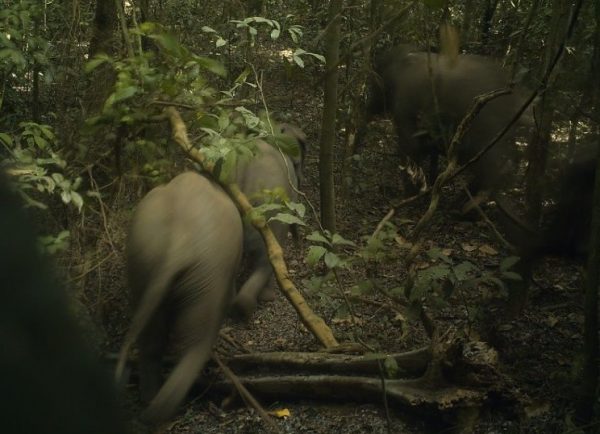6th July, 2019

The jungle was so thick that Emmanuel Olabode only found the elephants he was tracking when the great matriarch’s sniffing trunk reached out close enough to almost touch.
“She flapped her ears, blocking us to guard her family, then left in peace,” recalls Olabode. “It was extraordinary.”
The elusive elephants are just 100 kilometres from Lagos, Nigeria’s economic capital.
“They are scared of humans,” says Olabode, who leads the Forest Elephant Initiative, a conservation group in the Omo Forest, northeast of Lagos. “So they are active at night.”
Forest elephants are the shy relations of their larger savannah cousins and are experts at hiding; so skilled, in fact, very few in the city know about them.
The crowded concrete jungle of Lagos is better known for wild nightlife than nighttime wildlife.
“When people hear about the elephants, they do not believe it,” says Joy Adeosun, a government scientist working with Olabode.
“They are in shock,” adds Adeosun, fixing a motion-sensitive camera that has not only snapped elephants, but antelope, buffalo and chimpanzees too.
Omo, spreading across some 1,325 square kilometers of Ogun state, was protected as a government reserve nearly a century ago.
A UNESCO “biosphere reserve” of global importance, it is one of the last patches of pristine rainforest left in Nigeria.
Nigeria’s deforestation rates are among the highest in the world, according to the UN’s Food and Agriculture Organization.
“Chopping down trees is easy,” says Olabode, whose team of eight community rangers are overstretched.
“But if the forest goes, the whole ecosystem changes. The rains reduce, then the farms lose fertility. Everyone suffers.”
Half of the forest, a 650-square-kilometre area, is reserved for wildlife and logging is banned.
Researchers had feared only a handful of elephants were left. Then, in April 2018, the elephants burst out of the jungle.
Drivers slammed on their brakes as herds stampeded across a four-lane highway, with desperate mother elephants trying to smash central barriers for babies to cross, rangers said.
“They were looking for a new home,” Olabode explains, suggesting quarry blasts could have been the final straw.
Many were chased back, although some found a happy hideout even closer to the city.
Olabode now believes there could be a hundred elephants in Omo — but their remarkable survival is under threat like never before as their forest home is in danger.
Africa Nature Investors (ANI), a Nigerian conservation foundation, plans to develop eco-tourism to protect the forest.
“It will provide alternative employment,” says Filip Van Trier, a Belgian businessman brought up in Nigeria, outlining funding proposals he is heading for ANI, including tripling ranger numbers.
“But first we have to stop the logging.”
At dawn in Omo, monkey chatter echoes across misty treetops.
Then there is the echo of a gunshot, signalling that a hunter is in the forest. Soon after, the whine of chainsaws begins.
Both poachers and ivory dealers risk five years in prison — if laws were enforced.
In Omo, Olabode and his tiny team trek each day through the forests, trying to stop its destruction.
“If we let the forest go, people will say, ‘we should have protected the elephants’,” he says. “But by then, it will be too late.”
*Adapted from an AFP report on Omo Forest.


